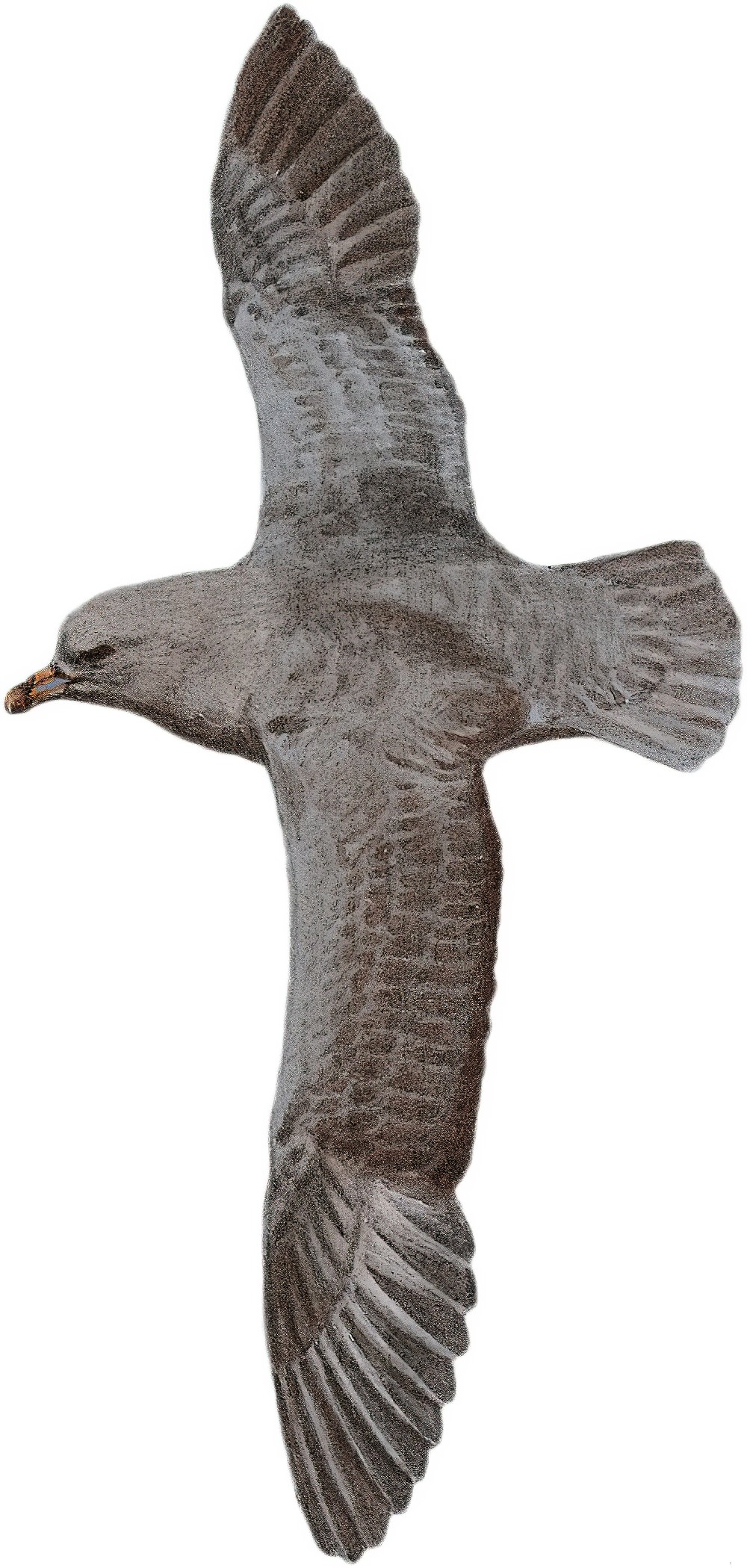Northern Fulmar / Fulmarus glacialis

Northern Fulmar
SCI Name:
Protonym: Procellaria glacialis FaunaSvecica.ed.2 p.51
Taxonomy: Procellariiformes / Procellariidae / Fulmarus
Taxonomy Code: norful
Type Locality: Within the Arctic Circle.
Author: Linnaeus
Publish Year: 1761
IUCN Status: Least Concern
DEFINITIONS
FULMARUS
(Procellariidae; Ϯ Northern Fulmar F. glacialis) Old Norse name Fúlmár foul-mew or -gull, for the Northern Fulmar (cf. "Fulmarus, i.e. Fulix maris s. Avis marina fuliginosa; nomen sane corruptum minusque bene formatum" (Sundevall 1873)); "FULMARUS. FULMAR. Generic Character. Rostrum grossum, ad apicem dilatatum, sulcatum; mandibula superiore adunca; inferiore recta subtruncata. Nares tubulatæ. Pedes mediocres; unguis posticus loco pollice. ... FULMARUS. Leach. WAGELLUS. Ray. PROCELLARIA. Linn., Gmel., Lath., Briss. THE Fulmars differ from their congeners in having the beak stronger, much hooked, suddenly swollen towards the tip, with the lower mandible somewhat truncated at the tip; the nostrils are united in a single groove or furrow on the beak: they are more diurnal than the others, and their nourishment chiefly consists of the flesh of dead cetacea, of mollusca, and vermes. ... NORTHERN FULMAR. (Fulmarus glacialis) ... Its food consists principally of fish, but it will devour indiscriminately any floating putrid substances, such as the filth of ships, which it fearlessly follows. These birds also follow the tracks of the wounded whales, and, when they are exhausted, alight on the carcases by hundreds, and ravenously pluck off and devour lumps of the blubber until they are satiated. This gross food causes them to become excessively fat, and their stomachs are always charged with oil, which they have the power of ejecting with force from the beak; and when attacked squirt it into the face of their enemy. ANTARCTIC FULMAR. (Fulmarus antarcticus.) ... GIGANTIC FULMAR. (Fulmarus giganteus)" (Stephens 1826); "Fulmarus Stephens, in Shaw, Gen. Zoöl., 13, pt. 1, 1826, p. 233. Type, by subsequent designation, Procellaria glacialis Linné. (Gray, List Gen. Subgen. Bds., 1855, p. 129.)" (Peters, 1931, I, p. 47).
Synon. Halohippus, Priocella, Rhantistes, Wagellus.
glacialis
L. glacialis icy < glacies ice (i.e. Arctic, northern).
● Newfoundland; ex “Long-tailed Duck” of Edwards 1760 (syn. Clangula hyemalis).
● Spitsbergen; ex “Equus marinus” of Clusius 1605, and Willughby 1676, “Mallemucke” of Martens 1675, “Vagellus cornubiensis” of Ray 1713, “Procellaria albicans, dorso canescente” of Linnaeus 1746, “Larus marinus maximus groenlandicus” of Anderson 1746, “Procellaria cinerea” of Brisson 1760, and “Procellaria Grönlandica” of Gunnerus 1761, and Strøm 1762 (Fulmarus).
● In Arctic Seas; ex “Plain Phalarope” of Pennant 1785, and Latham 1785 (syn. Phalaropus fulicarius).
● Kamchatka: "Ich gab ihr daher zum Unterschiede von unsrer Sterna Hirundo, der sie jedenfalls sehr nahe steht, den vorläufigen Namen: Sterna glacialis, sie heißt aber bereits bei Pennant und Pallas: Sterna kamtschatica. — Die Farbe der Iris ist bei ihr immer schwarzbraun." (von Kittlitz 1858) (syn. Sterna hirundo longipennis).
SUBSPECIES
Northern Fulmar (Atlantic)
SCI Name: Fulmarus glacialis glacialis/auduboni
FULMARUS
(Procellariidae; Ϯ Northern Fulmar F. glacialis) Old Norse name Fúlmár foul-mew or -gull, for the Northern Fulmar (cf. "Fulmarus, i.e. Fulix maris s. Avis marina fuliginosa; nomen sane corruptum minusque bene formatum" (Sundevall 1873)); "FULMARUS. FULMAR. Generic Character. Rostrum grossum, ad apicem dilatatum, sulcatum; mandibula superiore adunca; inferiore recta subtruncata. Nares tubulatæ. Pedes mediocres; unguis posticus loco pollice. ... FULMARUS. Leach. WAGELLUS. Ray. PROCELLARIA. Linn., Gmel., Lath., Briss. THE Fulmars differ from their congeners in having the beak stronger, much hooked, suddenly swollen towards the tip, with the lower mandible somewhat truncated at the tip; the nostrils are united in a single groove or furrow on the beak: they are more diurnal than the others, and their nourishment chiefly consists of the flesh of dead cetacea, of mollusca, and vermes. ... NORTHERN FULMAR. (Fulmarus glacialis) ... Its food consists principally of fish, but it will devour indiscriminately any floating putrid substances, such as the filth of ships, which it fearlessly follows. These birds also follow the tracks of the wounded whales, and, when they are exhausted, alight on the carcases by hundreds, and ravenously pluck off and devour lumps of the blubber until they are satiated. This gross food causes them to become excessively fat, and their stomachs are always charged with oil, which they have the power of ejecting with force from the beak; and when attacked squirt it into the face of their enemy. ANTARCTIC FULMAR. (Fulmarus antarcticus.) ... GIGANTIC FULMAR. (Fulmarus giganteus)" (Stephens 1826); "Fulmarus Stephens, in Shaw, Gen. Zoöl., 13, pt. 1, 1826, p. 233. Type, by subsequent designation, Procellaria glacialis Linné. (Gray, List Gen. Subgen. Bds., 1855, p. 129.)" (Peters, 1931, I, p. 47).
Synon. Halohippus, Priocella, Rhantistes, Wagellus.
Northern Fulmar (Pacific)
SCI Name: Fulmarus glacialis rodgersii
rodgersi / rodgersii
● Adm. John Rodgers (1812-1882) US Navy, explorer in the Pacific 1852-1856 (subsp. Fulmarus glacialis).
● Dr William Alan Rodgers (1944-2009) British zoologist, conservationist in Tanzania 1965-1984, 1992-2009, and India 1984-1991 (subsp. Swynnertonia swynnertoni).
UPPERCASE: current genus
Uppercase first letter: generic synonym
● and ● See: generic homonyms
lowercase: species and subspecies
●: early names, variants, mispellings
‡: extinct
†: type species
Gr.: ancient Greek
L.: Latin
<: derived from
syn: synonym of
/: separates historical and modern geographic names
ex: based on
TL: type locality
OD: original diagnosis (genus) or original description (species)












